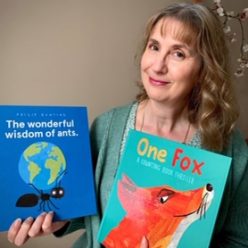Illustrated by the author

Published by G.P. Putnam’s Sons, New York, 1980
I just love this story about a knight in a castle and a dragon in a cave. With very few words, we are drawn into a story about destiny, expectations, life choices, success and failure, accepting good advice and thinking outside the box.
Because if you are a knight, then you should fight a dragon. Right?
And if you are a dragon, then you should fight a knight. Right?
Well, they both do their best to fulfil their roles. The knight goes to the library to borrow a book about fighting dragons and the dragon digs around in his cave for a book on how to fight knights. The knight builds up his collection of armoury and weaponry. The dragon practices his tail swishing, snarling, and fire-breathing.
The day of the contest arrives and despite their polite introductions, a bit of jousting, a lot of running and many attempts to topple each other, the knight ends up in a tree and the dragon ends up in a pond.
The princess librarian just happens to be passing by and saves the day with a couple of different books: an outdoor cookbook for the dragon (what better use could there be for his fiery breath?) and a manual for building barbeques for the knight (his building skills could really be put to good use there!).
And so, what began as a contest between two enemies becomes a partnership between two friends!
The illustrations in this story are gorgeous and because there are so few words, it gives the reader lots of scope for improvisation and storytelling. The dragon is not really that scary and the knight always has a smile even when he is sharpening his sword. I like the idea that we do not always have to become what we are expected to be. Sometimes, life can present you with different pathways and it’s okay to be different, step out into a new way of living and do what you never imagined!
I can highly recommend this picture book for children 4-6 years and below are more recommendations for stories which feature dragons:

by Robert Munsch
Illustrated by Michael Martchenko

by Peter Yarrow
and Lenny Lipton
Illustrated by Eric Puybaret

Illustrated by Lynn Munsinger


by Eric Carle
Compiled by Laura Whipple

by Peter Bently
Illustrated by Helen Oxenbury

by Debi Gliori

by Debi Gliori

by Fiona Watt
Illustrated by Rachel Wells

and the Princess
by Chris Wormell

Illustrated by Shane Devries

by Julia Donaldson
Illustrated by Axel Scheffler


by Lynley Dodd





by Helen Docherty
Illustrated by Thomas Docherty

by Anna Kemp
Illustrated by Sara Ogilvie





























































































































































































